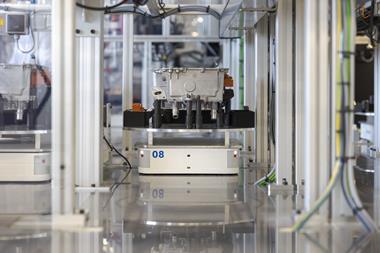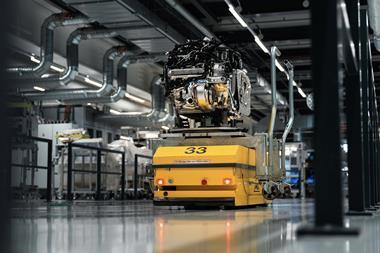Ergonomic developments in the manufacturing workplace are boosting efficiency and productivity
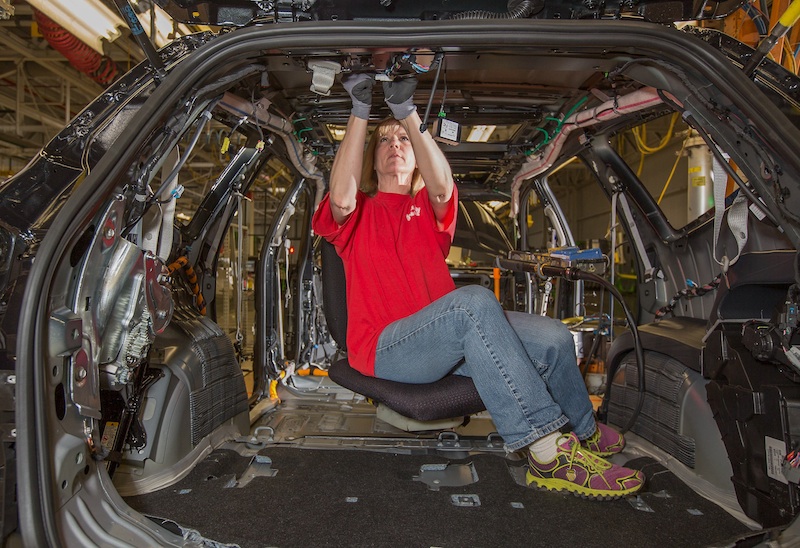
An ageing workforce coupled with the ever-present need to increase efficiency and achieve the perennial goal of doing more with less; growing product ranges and the increased complexity of parts and machines; the arrival of the next-generation workforce of digital natives who grew up thinking that swiping a screen is as natural as writing, and who bring their own set of expectations about how a factory should be run. These factors are all driving improvements in ergonomics in the automotive industry workplace.
For Audi, its workforce is its most important asset. This is why the company started its APSA ergonomics workplace assessment programme in 2004. The initiative is measured through a traffic light system; green if everything is going well, yellow if there are areas for improvement and red if a change needs to be made immediately. “To improve you must first know where you are,” says Markus Becker, head of Industrial Engineering at Audi.
Taking a holistic view
In previous years, Audi's annual worker assessments have mainly focused on physical health, but now the company is starting to take a more holistic view of the workplace, with an emphasis on psychological wellbeing. "We look at whether the work is interesting, if it makes the best use of an employee’s qualifications and if the worker received sufficient training to do the job,” says Becker. “We also take into account the working environment, such as lighting and temperature, as well as how well the employee is trained to do the job. These factors will all feature more prominently in the APSA test in the future.”
Audi also provides specific training to employees on the importance of ergonomics in the workplace, while generating ideas from employees through regular workshops and enabling different sites to exchange ideas and best practices. This is all part of the manufacturer's increasing focus on the ergonomics strategy it delivers through the ‘We for us. Active into the future’ initiative. Becker explains: “The goal of this programme is to continuously improve production workflows through using materials sparingly and reducing complexity wherever possible.”

Other ergonomic workplace improvements at a series of ‘Ergonomics Days’ in November at Audi’s main site in Ingolstadt, Germany, included a mirror that allows assembly employees to tighten screws at the front end of a vehicle while standing upright, instead of bending down. Another initiative came from paintshop workers at the Brussels plant who have developed a device that automatically opens the tailgate of an Audi A1. A team from the north German city of Neckarsulm also presented a newly designed pre-assembly table for the centre console, which can be adjusted to an employee’s individual needs to improve his or her posture.
"A well-designed ergonomic workplace operates very efficiently, produces high-quality products that satisfy our customers, has few errors and a low level of illness" – Markus Becker, Audi
Audi also understands that it must attract and retain the most talented employees by delivering the kind of ergonomically-designed environment that is attractive to the next generation of workers. “We know we have to fight for the best talent, especially here in Germany,” says Becker. “This not only involves having the right work environment in place, but also teaching the younger generation about the importance of workplace ergonomics.”
The manufacturer puts a great emphasis on the health and wellbeing of its workers because it appreciates that this will boost productivity. Becker explains: “A well-designed ergonomic workplace operates very efficiently, produces high-quality products that satisfy our customers, has few errors and a low level of illness."
Looking into the future, the company is exploring ways in which robots and humans can collaborate in a factory to manufacture its vehicles. “Robots can do the heavy lifting while humans take on the more complicated tasks,” explains Becker. “We’ve still a long way to go to achieve the necessary levels of safety, but it is the next technical step in ergonomics.”
GE's ergonomics & safety programmes
Ergonomics have been a priority at General Electric (GE) for more than a decade. All GE manufacturing sites and service organisations are expected to implement a comprehensive ergonomics programme, which must address industrial and office environments. Ergonomics has been a part of GE’s Environmental Health and Safety (EHS) Management System, which it calls its EHS Framework, since its inception. Each site is measured annually on the implementation of all GE EHS expectations, including ergonomics, as part of the EHS Framework Scorecard audit process.
In recent years, GE sites have been increasingly leveraging ergonomics not only to prevent and reduce musculo-skeletal injuries, but also to improve the efficiency, productivity and the quality of its operations. Embedding ergonomics within its lean initiatives is one means of doing so; the company has also launched ergonomics engineering training.
Lisa Brooks, manager, Ergonomics and Safety Programmes at GE, explains: “These courses specifically target manufacturing, lean and product development engineers. Previously our engineers had been attending the same training as the site ergonomics teams. This new training talks to engineers in their language and shows them how the implementation of ergonomics principles will advance the metrics that they are measured on every day.”
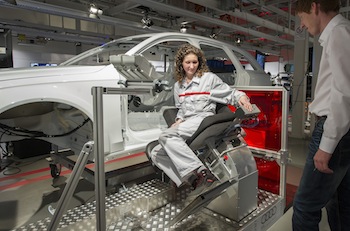
“The Ergo Cup Competition began as a way to share, showcase and recognise innovative ergonomics projects and teams across GE, but this initiative has grown and evolved in ways that we never imagined when it began,” says Brooks. “Sites work all year to improve ergonomics and are always looking for the best project to enter into the competition. The competition has driven sites to examine and improve their evaluation processes and facilitated a broader capture of benefits from their ergonomics projects. Overall, the Ergo Cup Competition has increased the enthusiasm, visibility and effectiveness of our ergonomics programmes, and is making our operations safer and more efficient.”
Ergonomics analysis tools
General Motors’ ergonomics efforts began in the mid-90s, when the company developed its initial formalised programme with its UAW partners. The programme includes training, developing ergonomics analysis software tools and buying ergonomics assessment hardware.
“Each General Motors UAW plant has a Joint Ergonomics Technician Team (JETT) that coordinates the plants’ ergonomic process,” explains Dave Bentoski, senior manufacturing project engineer at General Motors. “We collaborate with the General Motors medical organisation to ensure ergonomic incidents are identified quickly, and we have improved our reporting processes throughout all levels of the organisation. We have also enhanced our ergonomic design process over the last few years.”
In addition, General Motors has devised an ergo chair, which it used to help develop the mid-sized Chevrolet Traverse SUV vehicle at its Lansing Delta Township Assembly Plant in Lansing, Michigan. More specifically, the chair is being used for the SUV's family-friendly third row, which can fit three adult passengers who all have their own safety systems, infotainment, lights, climate control and coat hooks.
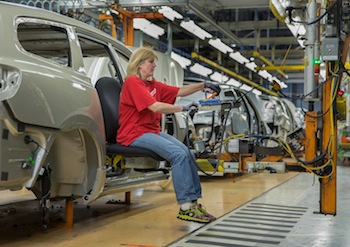
“The primary reasons the ergo chair was developed are: safety, the benefits to the employee’s health, and to conveniently and efficiently move the employee as well as the necessary tools and parts into the back of the vehicle during the assembly process,” says Bentoski.
“Additional benefits of technological advancements such as the ergo chair are that they increase productivity at our manufacturing facilities and improve the level of quality of the products we produce.” The ergo chair is also being used at the General Motors' Spring Hill Manufacturing facility in Tennessee and the company will continue to evaluate potential applications in different facilities where this technology can help employees stay safe and healthy.
However, it's not just about equipment, as General Motors currently has comprehensive ergonomics design processes, which include standardised work for manufacturing engineering (ME) and product engineering (PE) and feedback from the plant JETTs on future vehicle programme teams. “The ME and PE organisations increasingly use maths-based tools, such as digital human models, that can simulate jobs and interact with product maths data early on in the design process,” says Bentoski.
“For example, a vehicle product engineer will ask how far an operator can reach to install a component, then the digital human model is used to determine that acceptable reach distance in maths before the design of the vehicle is finalised. We continue to drive forward maths-based improvements in our methods and processes.”
























